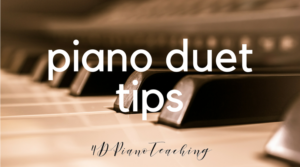“A duet for you, a duet for you,… a duet for everyone!” Applause and shouts of joy come from all students as you hand out duets in your studio.
Sound like the perfect scene? It does to me. I love when students get excited about playing piano together! Yet often, the response I get is “Do I have to?” So I’m setting out to fix that in my studio this semester. My goal is to help every student LOVE piano duets and ensembles. Today I wanted to share a few of my favorite tricks to get duets going in my studio:
1. Choose music students like to play.
I know, I know there is so much wonderful classical duet repertoire but I’m guilty of rarely pulling it out. As much as my students love their Clementi Sonatinas or Bach Minuets, there’s a different energy and excitement that runs through them when I pull out Get Up and Go (Robert Vandall) or Straw Hat Strut (Martha Mier). We do enough solo repertoire work that when I finally pull out duet music, I tend to go with something they will absolutely love. I really want their memories of duet experiences to be the BEST.
2. Sibling Duets & Trios
Siblings make the best practice partners – they often have back to back lessons and since they live together, it’s easier to schedule practicing. Sometimes we even get a parent involved in the ensemble, which makes it even better! Now most families love having their children practice and perform together – the most amazing memories are made as they create music together! However, there is the occasional family that would rather not venture into this due to fighting between siblings. Just check with parents first and then go for it!
3. Schedule Back-To-Back Lessons
What’s more fun than having a friend do something with you?! When I think two piano students are “buddies” in group class, I will often try to match them up for a duet. When the new semester scheduling starts, I try to work with parents to put their children’s lessons back to back. It’s so fun to have them visit as they pass each other in lessons! And it makes the perfect duet buddy. About every other week, I ask parents to bring the 2nd student 5-10 minutes early. Then with 5-10 minutes at the end/beginning of each lesson, we end up with 10-20 minutes of duet time! They love having this break from private lessons to play together and work on ensemble skills! It really brings a new energy to the piano lesson!
Now another advantage to these back-to-back lessons is performance practice. When we’re preparing for a recital, they can play for each other a few times at the end/start of their lessons as well. It always helps them prepare for the upcoming festival or larger audience at the recital!
4. Mixed Levels
Sometimes, teachers tell me they just don’t know how to pair up students for duets or trios. They’re all at different levels and you don’t want to put a late to start beginner at 11 yr old with a fast learning 7 yr old flying through their books?! So I often suggest mixed level duets. This mixed level repertoire is great for siblings too. Try having more advanced students learn the teacher duet part of a piece to get started with these trickier pairings.
5. Just Do It!
Finally, the hardest part can be just getting started! Remember that not every duet will work out and not every pairing will be a students’ favorite. Sometimes you just have to get going and the ball will start rolling. My goal is to try to have each student do at least one duet every 6 months.
I’ve found that upcoming performances for duets make practice better 😉 So include duets in your end of semester recital or make a group class all about duets and let students perform for each other. I love showing any of the Anderson and Roe duet videos – seriously what student would not want to play a duet after seeing this?!
Author: Whitney
Whitney Hawker, NCTM, teaches group and private piano at Weber State University, Utah. She loves surprising students with the perfect piece or a new exciting game! After graduate school, she missed sharing ideas and resources daily with colleagues so she and her friend, Spring, began blogging together at 4DPianoTeaching.com

